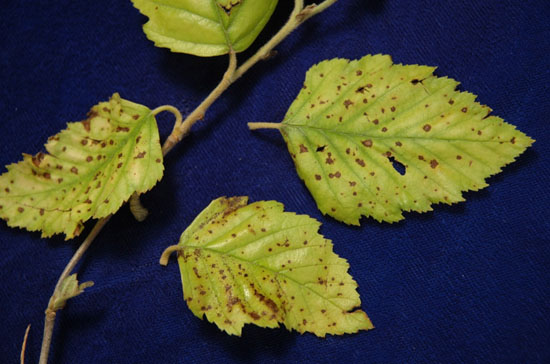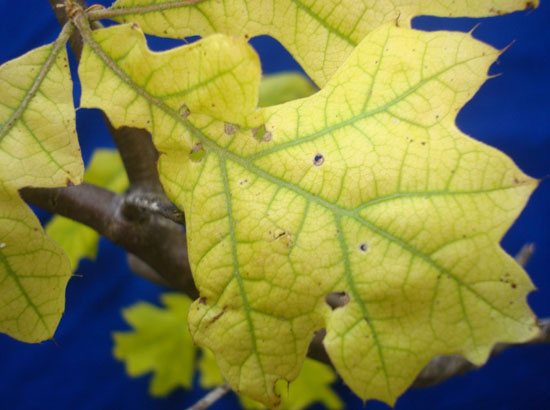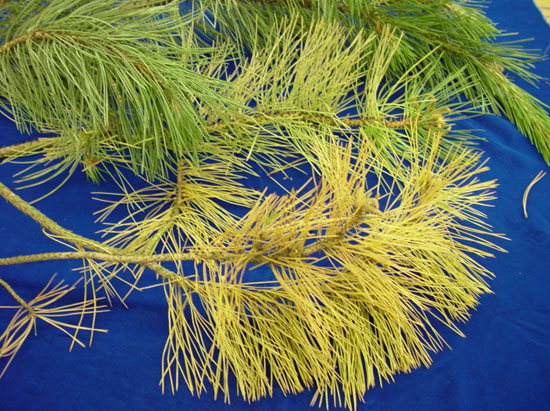Issue 8, June 13, 2011
Trees/Shrubs Seen at the U of I Plant Clinic due to Site Stress
Hello, my tree has a problem. Now what can I do to fix it? What can I spray on the tree to make it better? These are common questions coming into the U of I Plant Clinic on a daily basis. We encourage clients to send a sample, so that we can make a diagnosis, and provide management recommendations. But, what if the problem is not related to a disease or insect? Now what? Well, there may not be many options to correct the problem, because it just might be that the tree or shrub has problems because of the site in which they are planted.
Here are some of the site issues that can stress trees or shrubs: improper planting, wrong planting zone, non-native plant species, incorrect soil type, compaction, soil pH too high or low, inadequate fertility, too much shade or sun, too wet or dry, crowded planting, construction after planting, or just not suitable for an urban setting.

Birch with Crytocline and chlorosis (photo by Nancy Pataky)
There are many diseases of birch that can cause decline or dieback; however no matter what the pathogen may be, it is because the birch is under stress. According to Michael Dirr, in his book, Manual of Woody Landscape Plants, most birches do best in well-drained soils, acid, moist, sandy or silty loam soils. He states that he would not plant a river birch (Betula nigra) unless the soil pH were 6.5 or below. However, there are some birch species that are more adapted to a variety of soil types and moisture levels, but they will become very chlorotic in high pH soils (as seen in the picture).

Pin oak with iron chlorosis (photo by Stephanie Porter)
In Illinois, iron chlorosis is common on many tree species, the most common being pin oak. In most cases the soil has plenty of iron for tree growth but our high pH soils bind up the iron making it unavailable to the roots. Iron is available to plants only as the Fe++ ion, and is available in that form only when the soil pH is between 5.0 and 6.5. Soils that have high levels of zinc, manganese, or copper also aggravate the iron chlorosis problem. This is also the case with large amounts of limestone or ash, potassium deficiency, or excessive applications of fertilizers high in phosphorus. For more information about iron chlorosis, refer to: http://ipm.illinois.edu/diseases/rpds/603.pdf

White pine decline
We have seen white pine problems in Illinois for several decades. Generally, the white pine is in decline and no disease pathogens, insects, or nematodes have been associated with the decline of white pine. The common problem appears to be root issues, due to heat, drought, flooding, girdling roots, deep planting, high pH, and sudden extremes in temperature and moisture. White pines are understory tress that thrive in the cool, moist, well-drained soils of Wisconsin. They have been found not to do well in clay sites that may be exposed to the elements, so site stress may also be contributing to the decline of these trees. In addition, white pines grow best in a soil with a pH of 5.5 - 6.0; however Illinois landscapes often have a fairly high pH.

Yew symptoms suspect of "wet feet." (Photo by Stephanie Porter)
Yew is extremely intolerant to even short periods (one to two weeks) of saturated soil. They begin to die back and may even die out completely in some cases. The symptoms are a fairly uniform death of the newest growth, while older leaves showed progressive dieback beginning at the leaf tip. These symptoms, coupled with the presence of excessive soil moisture, often make the diagnosis pretty straightforward: it is "wet feet." In addition, yews do not do well in a location where there can be high winds, extreme heat, and needles can brown or yellow in the winter due to desiccation.
These are just four examples of plant problems that can result because of a site issue. Many homeowners need to assess their site before planting a new tree or shrub. If you need some help with selecting trees or shrubs, the U of I Extension has several good websites that can help. They are as follows:
http://urbanext.illinois.edu/treeselector/
http://urbanext.illinois.edu/ShrubSelector/
http://urbanext.illinois.edu/treeselect/
(Stephanie Porter)
Author:
Stephanie Porter